#chuck lanza
Explore tagged Tumblr posts
Text
5. Animaciones oficiales 🎬
a) Animación de Temporada: "Ranger Ranch" 🚂
(Lanzamiento de hipercargas y debut de Chuck)
🎵 Música de fondo:
“Orpheus in the Underworld” – Jacques Offenbach
(pieza clásica usada en tono cómico y acelerado, común en caricaturas)
• En el desierto, los sheriffs Colt y Shelly custodian su comisaría. Bull, Sam y Chuck están presos.
• La celda de Chuck es completamente distinta: blindada con metal, cadenas, código y un cartel de "Danger".
• Belle y Pearl atacan para rescatar a Sam. Chuck, al oír la explosión, comienza a "dirigir" la escena con su batuta, con los ojos cerrados y ajeno al caos.
• Colt y Shelly usan hipercargas para vencer a Belle y Sam. Pearl, furiosa, activa la suya y destruye el lugar.
• La celda de Chuck desaparece con la explosión. Al perder su batuta (que se desvanece como ceniza), se enfurece.
• Acelera con gran energía en su silla-tren y atropella a todos, lanzándolos por los aires.
• Cierra con Chuck poseído por una furia desbordante, y Pearl huyendo con sus padres en brazos.
💡 Características que demuestra Chuck:
- Teatral y excéntrico: convierte el caos en su propia sinfonía.
- Impredecible y peligroso: la celda especial lo anticipa; la furia lo confirma.
- Impulsivo: la pérdida de su batuta desencadena su violencia.
- Dominante cuando se desata: una fuerza arrolladora, literalmente.
b) Animación de Lanzamiento: "Shade" 👻
(Estación del Starr Rail)
• Chuck detiene su tren en la estación vacía del Starr Rail e invita a Gus a subir.
• Gus se sienta junto a un montón de ropa (Shade aún sin forma). Deja su llavero.
• Shade se manifiesta y se hace amigo de Gus; juegan y se abrazan.
• Chuck, al oír la risa de Gus, gira la cabeza con una sonrisa amable… que se transforma en confusión al ver a Gus reír "solo" junto a un montón de ropa inerte.
• El tren llega a otra estación y Gus se baja junto a Shade.
💡 Características que demuestra Chuck:
- Amable y profesional: trata a Gus con cortesía, sin cuestionarlo.
- Curioso y expresivo: su cara refleja sorpresa y desconcierto.
- Ignorante del plano sobrenatural (aún): no comprende a Shade en este punto.
- Menos agresivo, más contenido que en su debut.
c) Mini Animación Promocional de Shade 🌀
(Short animado)
• En la estación, Shade está de pie tranquilo.
• Chuck pasa volando con su tren, acelerando intencionalmente con una sonrisa pícara.
• Shade es arrastrado por el viento. Fin.
💡 Características que demuestra Chuck:
- Pícaro y juguetón: se divierte molestando a Shade.
- Ahora sí lo reconoce: ya sabe que Shade es real.
- Ligero y burlón, en contraste con su versión explosiva anterior.
d) Animación tráiler – Temporada "Super Brawl" ⚡
(Tráiler épico del universo alterno con héroes vs villanos)
📝 Resumen:
• La ciudad de Starr Park está en ruinas, con un cielo rojo y graffiti que dice “We don’t need more power ups”.
• En primer plano, una figura encapuchada observa la escena.
• Corte a Insector Carl riendo y causando estragos. A su lado, Electroid Chuck persigue y electrocuta a Mr. P y una chica que huyen aterrados. Luego, Justice Smasher Bibi aparece destruyendo estructuras con su bate.
• Firewing Janet (voz en off): “Starr Park is falling apart. Crime is running the streets.”
• La figura misteriosa se revela como Firewing Janet , quien rescata a Spike y vuela con él.
• Desde lo alto de la rueda de la fortuna, Electroid Chuck e Insector Carl electrocutan a Stu. Carl ordena:
• “Toss him.”
• Chuck lo lanza. Stu cae, y Janet lo alcanza.
• Janet: “Stay with me, papa.”
• Stu: “It’s OK… please take care of your sis…”
• Janet se alza furiosa. Pero Justice Smasher Bibi aparece y ambas forcejean.
• Bibi: “Give up. You won’t win.”
• Janet: “You’ve crossed the line!”
• Insector Carl amenaza a **Bonnie**, pero Janet se libera del forcejeo y **bloquea el ataque**, protegiéndola justo a tiempo.
• Janet (voz en off): “Heroes are supposed to protect.”
• Desde una terraza, Protector Grom observa en silencio:
• “I’m Grom.”
• Equilibrium Buster sostiene un muro que colapsa.
• Spectacular Sam ayuda a reparar estructuras.
• Janet: “As long as people need me… I’ll keep trying. But I can’t do this alone.”
• “I’ve got back up.”
• En la toma final:
• Insector Carl: “Time to turn the world into a giant rock.”
• Electroid Chuck corre dejando llamas, Bibi salta sobre ellas con su bate, y Janet los rodea desde el aire.
• Formación final: héroes vs villanos.
💡 Características que demuestra Electroid Chuck:
- Cruel y destructivo: ataca con saña, disfruta electrocutar a civiles y a Stu.
- Cómplice activo del caos: actúa coordinado con Insector Carl, mostrando su rol de villano estructurado.
- Explosivo y simbólico: deja fuego a su paso, reflejando su intensidad.
- Presencia escénica impactante: sin diálogo, su lenguaje corporal lo hace imponente.
- Villano de película: teatral y dramático, ideal para una producción ficticia de acción dentro del universo de Brawl Stars.
0 notes
Photo

September 25, 1957: Sixty-two years ago today Buddy, pictured here in his hometown of Lettsworth, Louisiana, boarded a train to Chicago with nothing but his guitar and a promise to his mother. The rest, as they say, is music history.
- Team BG Photo by Chuck Lanza
https://mobile.twitter.com/TheRealBuddyGuy/status/1176919642356551687
86 notes
·
View notes
Text
Choco Valens lanza nuevo sencillo "Chuck-E" antes de Halloween
Choco Valens lanza nuevo sencillo “Chuck-E” antes de Halloween
chocolate valente regresa justo a tiempo antes de que llegue Halloween con una canción que seguramente seguirá siendo un clásico de octubre en su catálogo anterior, “Chuck-E”. Compartir en Facebook Compartir en Twitter Compartir en Reddit Compartir en Pinterest Compartir por correo electrónico

View On WordPress
0 notes
Text

tras las cinias el jardinero también bebe de la manga
after the zinnias the gardener, too, drinks from the hose
Paul O. Williams
*
pisando seroja... echo a volar gorriones camino abajo
walking in dead leaves— sending the sparrows flying further down the path
lluvia radiactiva Buda sigue sonriendo a la última mariposa
In atomic rain Buddha goes on smiling at the last butterfly
James Kirkup
*
últimos rayos un hombre lanza una estrella de vuelta al mar
the last rays a man hurls a starfish back into the sea
Chuck Brickley
*
callada en la cena la hez suspensa en el vino
her silence at dinner sediment hanging in the wine
Scott Montgomery
*
el teléfono timbra una vez sólo lluvia otoñal
the telephone rings only once autumn rain
riela la aurora boreal un tecolote chifla en la orilla lejana
northern lights shimmer a saw-whet piping on the distant shore
hondo en el bosque mustio un arce grana
deep inside the faded wood a scarlet maple
Nick Avis
*
lluvia vespertina... trenzo mi pelo con la sombra
evening rain— I braid my hair into the dark
cuenco roto los trozos aún cunean
broken bowl the pieces still rocking
monumento a los caídos... las mariposas migratorias tapan los nombres
the war memorial— migrating butterflies cover the names
Penny Harter
*
mañana de relente: la troncos del camión sudan savia
dewy morning: the logging truck's load sweating sap
más adentro cuanto más se aparta bruma vernal
walking farther into it the farther it moves away spring mist
hondo recodo del arroyo charleta del guardarrío tras el chapuz
deep bend of the brook the kingfisher's chatter after its dive
sombra tras sombra la banda de gansos viajeros cruzando entre nosotros
shadow after shadow the flock of migrating geese passing through us
Wally Swist
#haiku en inglés#Paul O. Williams#James Kirkup#Chuck Brickley#Scott Montgomery#Nick Avis#Penny Harter#Wally Swist#traducción©ochoislas
8 notes
·
View notes
Text
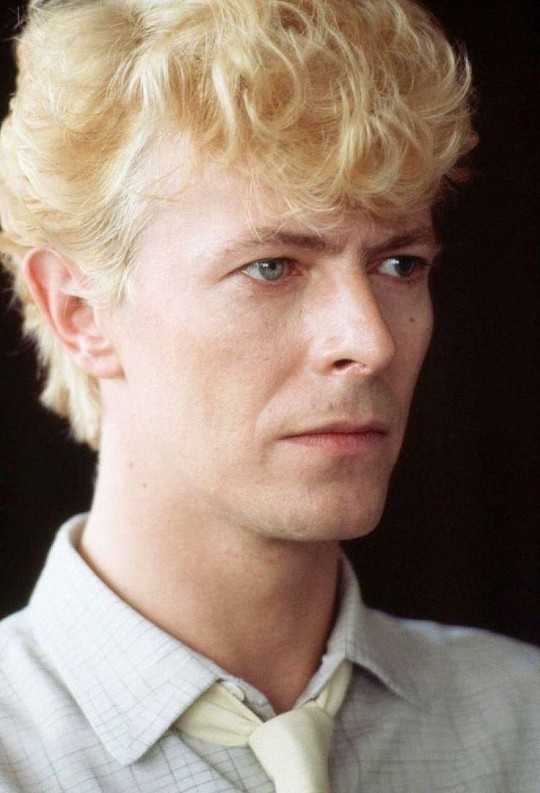
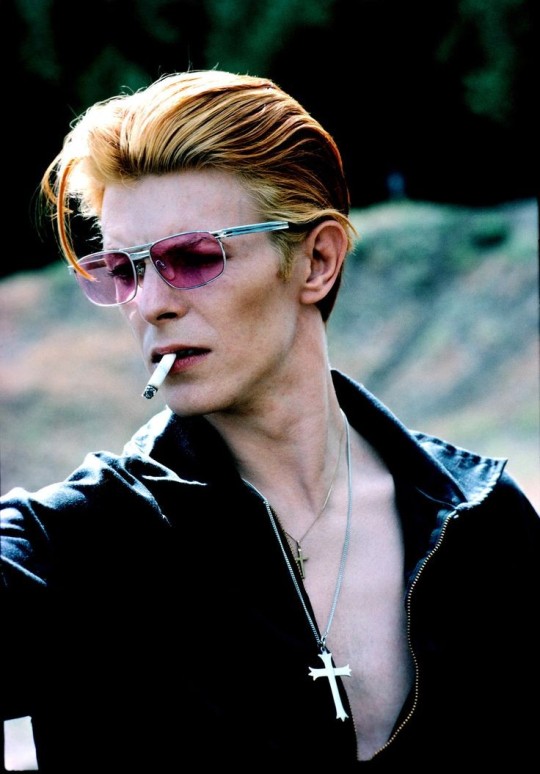


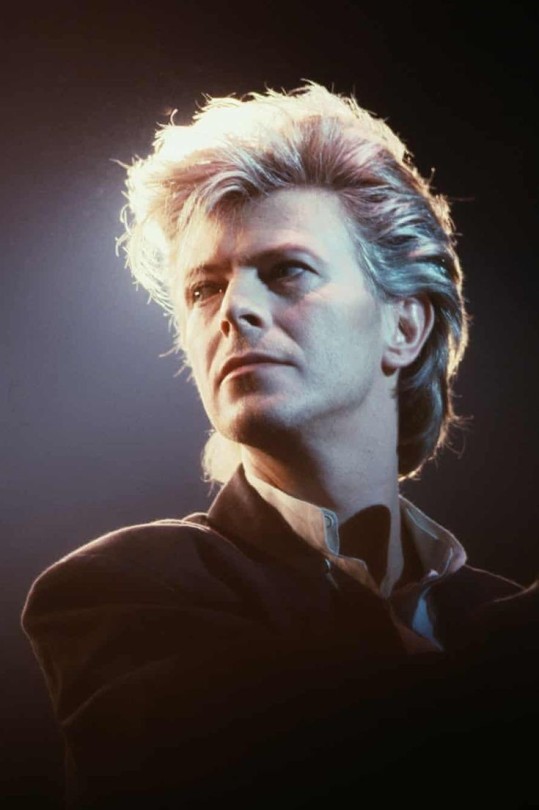
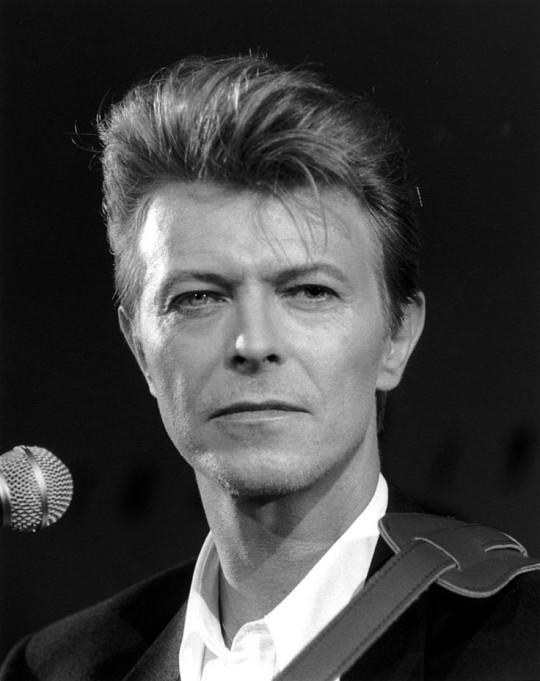

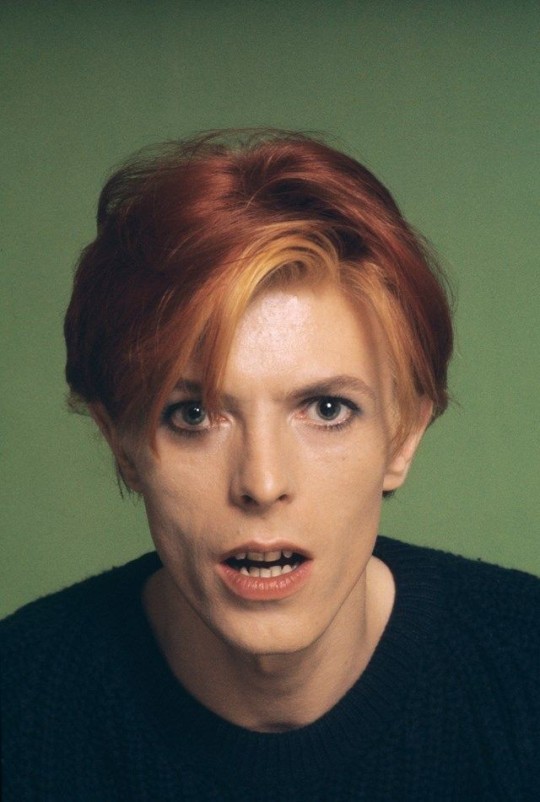
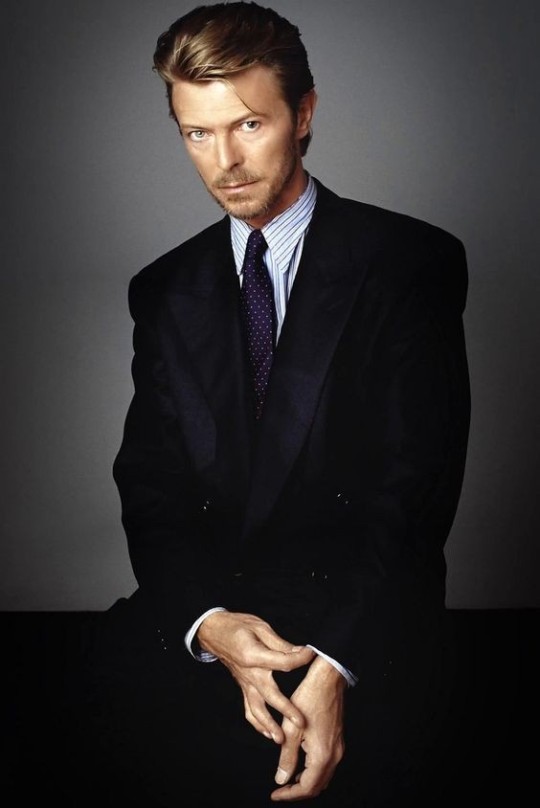
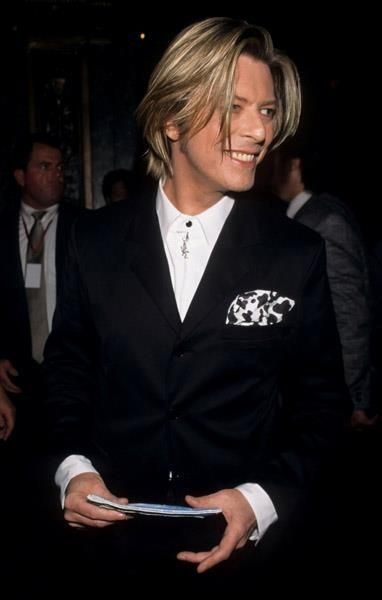
DAVID BOWIE
El 10 de Enero de 2016, en New York, EEUU, moría el Duque Blanco del Rock. Ese día se apagaba la vida de David Bowie. Nació en Londres, Reino Unido, el 8 de Enero de 1947 con el nombre de David Robert Jones, en sus primeros años escolares se ganó la reputación de rebelde y pendenciero pero también la de superdotado. A los 8 años ingresó en el Burnt Ash Junior School donde se perfeccionó en actuación y desarrolló su habilidad con instrumentos de viento, estos no tenían lugar en la música que lo apasionaba como la de Elvis Presley o Chuck Berry, fue en el Jazz donde pudo canalizar su talento, David hacía magia con el Saxo. Contrariamente a la creencia popular, David no tenía los ojos de distinto color, eran iguales, solo que el izquierdo tenía la pupila total y constantemente dilatada como consecuencia de una pelea en la adolescencia, esto le dejó de por vida un problema para determinar la distancia a la que estaban los objetos. En los inicios de su carrera cambiaba constantemente de banda y de estilo, integró "Kon Rads", "The King Bees", "Lower Third", "The Buzz" y "The Riot Squad", en 1967 deja de ser uno mas de una banda y lanza su primer disco solitario, para eso cambió su nombre a Bowie en honor al mercenario y aventurero Jim Bowie. Su formación actoral y de mimo se notaban en cada recital, no era un músico mostrando sus canciones, era un montaje teatral integral. Sus inicios en solitario fueron dirigidos por el manager Ken Pitt, quien consiguió que grabase varios sencillos en Pye en el año 1966. Debutó con “Can’t Help Thinking About Me” un single producido por Tony Hatch grabado en su período con Lower Third que fue interpretado en el programa Ready Steady Go con The Buzz.
Posteriormente publicó “Do Anything You Say”, “I Dig Everything” y “Rubber Band”, canción publicada en Deram con la cara b “The London Boys”. En estos inicios Bowie se movía en sonidos mod-pop, folk, R&B y vodevilescos, con influencias de Bob Dylan, Anthony Newley, The Kinks o The Beatles. En Pye grabó el sencillo “The Laughing Gnome”, número 6 británico en el año 1967.
La composición “Space Oddity”, canción influenciada por la película de Stanley Kubrick “2001: Una Odisea En El Espacio”, le proporcionó su primera grabación de éxito, alcanzando el puesto 5 en las listas británicas, y enfatizó sus ademanes teatrales que se subrayarían en años posteriores.
Fue la primera producción de Tony Visconti (a excepción del single homónimo) para Bowie en un notable disco con trazas de cantautor con resonancias folk, prog rock y psicodélicas en el que colaboraron músicos como Rick Wakeman, Paul Buckmaster o Herbie Flowers.
Cuando pasó del Folk Psicodélico al Glam Rock encontró su lugar en el mundo, lo hizo a través de un personaje sin inhibiciones al que llamó "Ziggy Stardust", con rictus femenino o andrógino, túnicas y cabello rojizo editó "The Rise and Fall of Ziggy Stardust and the Spiders from Mars". Nunca se estancó en un estilo, recorrió el Hard Rock, New Romantic, New Wave y Electrónica, en todas se destacó y dejó huella. Más abajo pongo un enlace a su extensa discografía.
Su carrera cinematográfica es tan extensa como la musical destacándose sus papeles en "El hombre que vino de las estrellas", "El Ansia", "Laberinto" y su inolvidable papel de Poncio Pilatos en "La última tentación de Cristo". A mediados de 2014 se le diagnosticó cáncer de hígado, decidió mantenerlo en secreto y continuar con su carrera normalmente, sabiendo que su muerte lo esperaba en el corto plazo decidió que fuera parte de acto final, grabó el disco "Blackstar" y fue manejando su fecha de lanzamiento para cuando el final estuviera cerca. El disco fue presentado el día de su cumpleaños, 2 días después Bowie fallecía en su departamento de New York.
#Porsimelees❤
https://www.alohacriticon.com/musica/grupos-y-solistas/david-bowie/
https://es.wikipedia.org/wiki/Anexo:Discograf%C3%ADa_de_David_Bowie
7 notes
·
View notes
Text
Marvin Gaye
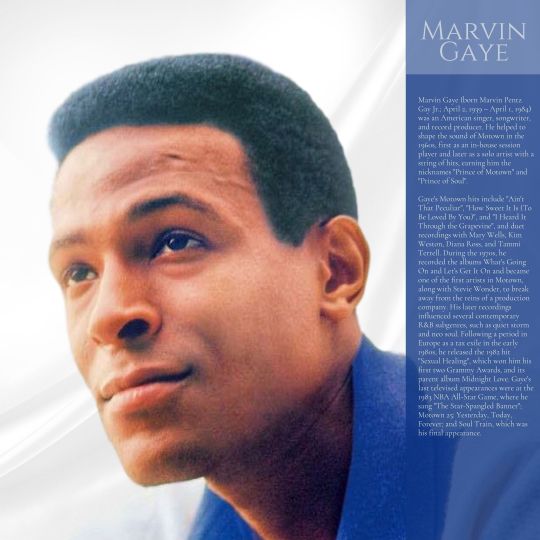
Marvin Gaye (born Marvin Pentz Gay Jr.; April 2, 1939 – April 1, 1984) was an American singer, songwriter, and record producer. He helped to shape the sound of Motown in the 1960s, first as an in-house session player and later as a solo artist with a string of hits, earning him the nicknames "Prince of Motown" and "Prince of Soul".
Gaye's Motown hits include "Ain't That Peculiar", "How Sweet It Is (To Be Loved By You)", and "I Heard It Through the Grapevine", and duet recordings with Mary Wells, Kim Weston, Diana Ross, and Tammi Terrell. During the 1970s, he recorded the albums What's Going On and Let's Get It On and became one of the first artists in Motown, along with Stevie Wonder, to break away from the reins of a production company. His later recordings influenced several contemporary R&B subgenres, such as quiet storm and neo soul. Following a period in Europe as a tax exile in the early 1980s, he released the 1982 hit "Sexual Healing", which won him his first two Grammy Awards, and its parent album Midnight Love. Gaye's last televised appearances were at the 1983 NBA All-Star Game, where he sang "The Star-Spangled Banner"; Motown 25: Yesterday, Today, Forever; and Soul Train, which was his final appearance.
On April 1, 1984, the day before his 45th birthday, Gaye's father, Marvin Gay Sr., fatally shot him at their house in the West Adams district of Los Angeles. Many institutions have posthumously bestowed Gaye with awards and other honors including the Grammy Lifetime Achievement Award, and inductions into the Rhythm and Blues Music Hall of Fame, the Songwriters Hall of Fame, and the Rock and Roll Hall of Fame.
Early life
Gaye was born Marvin Pentz Gay Jr. on April 2, 1939, at Freedman's Hospital in Washington, D.C., to church minister Marvin Gay Sr., and domestic worker Alberta Gay (née Cooper). His first home was in a public housing project, the Fairfax Apartments (now demolished) at 1617 1st Street SW in the Southwest Waterfront neighborhood. Although one of the city's oldest neighborhoods, with many elegant Federal-style homes, Southwest was primarily a vast slum. Most buildings were small, in extensive disrepair, and lacked both electricity and running water. The alleys were full of one- and two-story shacks, and nearly every dwelling was overcrowded. Gaye and his friends nicknamed the area "Simple City", owing to its being "half-city, half country".
Gaye was the second oldest of the couple's four children. He had two sisters, Jeanne and Zeola, and one brother, Frankie Gaye. He also had two half-brothers: Michael Cooper, his mother's son from a previous relationship, and Antwaun Carey Gay, born as a result of his father's extramarital affairs.
Gaye started singing in church when he was four years old; his father often accompanied him on piano. Gaye and his family were part of a Pentecostal church known as the House of God. The House of God took its teachings from Hebrew Pentecostalism, advocated strict conduct, and adhered to both the Old and New Testaments. Gaye developed a love of singing at an early age and was encouraged to pursue a professional music career after a performance at a school play at 11 singing Mario Lanza's "Be My Love". His home life consisted of "brutal whippings" by his father, who struck him for any shortcoming. The young Gaye described living in his father's house as similar to "...living with a king, a very peculiar, changeable, cruel, and all powerful king." He felt that had his mother not consoled him and encouraged his singing, he would have killed himself. His sister later explained that Gaye was beaten often, from age seven well into his teenage years.
Gaye attended Syphax Elementary School and then Randall Junior High School. Gaye began to take singing much more seriously in junior high, and he joined and became a singing star with the Randall Junior High Glee Club.
In 1953 or 1954, the Gays moved into the East Capitol Dwellings public housing project in D.C.'s Capitol View neighborhood. Their townhouse apartment (Unit 12, 60th Street NE; now demolished) was Marvin's home until 1962.
Gaye briefly attended Spingarn High School before transferring to Cardozo High School. At Cardozo, Gaye joined several doo-wop vocal groups, including the Dippers and the D.C. Tones. Gaye's relationship with his father worsened during his teenage years, as his father would kick him out of the house often. In 1956, 17-year-old Gaye dropped out of high school and enlisted in the United States Air Force as a basic airman. Disappointed in having to perform menial tasks, he faked mental illness and was discharged shortly afterwards. Gaye's sergeant stated that he refused to follow orders. Gaye was issued a "General Discharge" from the service.
Career
Early career
Following his return, Gaye and his good friend Reese Palmer formed the vocal quartet The Marquees. The group performed in the D.C. area and soon began working with Bo Diddley, who assigned the group to Columbia subsidiary OKeh Records after failing to get the group signed to his own label, Chess. The group's sole single, "Wyatt Earp" (co-written by Bo Diddley), failed to chart and the group was soon dropped from the label. Gaye began composing music during this period.
Moonglows co-founder Harvey Fuqua later hired The Marquees as employees. Under Fuqua's direction, the group changed its name to Harvey and the New Moonglows, and relocated to Chicago. The group recorded several sides for Chess in 1959, including the song "Mama Loocie", which was Gaye's first lead vocal recording. The group found work as session singers for established acts such as Chuck Berry, singing on the hits "Back in the U.S.A." and "Almost Grown".
In 1960, the group disbanded. Gaye relocated to Detroit with Fuqua where he signed with Tri-Phi Records as a session musician, playing drums on several Tri-Phi releases. Gaye performed at Motown president Berry Gordy's house during the holiday season in 1960. Impressed by the singer, Gordy sought Fuqua on his contract with Gaye. Fuqua agreed to sell part of his interest in his contract with Gaye. Shortly afterwards, Gaye signed with Motown subsidiary Tamla.
When Gaye signed with Tamla, he pursued a career as a performer of jazz music and standards, having no desire to become an R&B performer. Before the release of his first single, Gaye was teased about his surname, with some jokingly asking, "Is Marvin Gay?" Gaye changed the spelling of his surname by adding an e, in the same way as did Sam Cooke. Author David Ritz wrote that Gaye did this to silence rumors of his sexuality, and to put more distance between himself and his father.
Gaye released his first single, "Let Your Conscience Be Your Guide", in May 1961, with the album The Soulful Moods of Marvin Gaye, following a month later. Gaye's initial recordings failed commercially and he spent most of 1961 performing session work as a drummer for artists such as The Miracles, The Marvelettes and blues artist Jimmy Reed for $5 (US$43 in 2019 dollars) a week. While Gaye took some advice on performing with his eyes open (having been accused of appearing as though he were sleeping), he refused to attend grooming school courses at the John Roberts Powers School for Social Grace in Detroit because of his unwillingness to comply with its orders, something he later regretted.
Initial success
In 1962, Gaye found success as co-writer of the Marvelettes hit, "Beechwood 4-5789". His first solo hit, "Stubborn Kind of Fellow", was later released that September, reaching No. 8 on the R&B chart and No. 46 on the Billboard Hot 100. Gaye reached the top 40 with the dance song, "Hitch Hike", peaking at No. 30 on the Hot 100. "Pride and Joy" became Gaye's first top ten single after its release in 1963.
The three singles and songs from the 1962 sessions were included on Gaye's second album, That Stubborn Kinda Fellow. Starting in October of the year, Gaye performed as part of the Motortown Revue, a series of concert tours headlined at the north and south eastern coasts of the United States as part of the Chitlin' Circuit. A filmed performance of Gaye at the Apollo Theater took place in June 1963. Later that October, Tamla issued the live album, Marvin Gaye Recorded Live on Stage. "Can I Get a Witness" became one of Gaye's early international hits.
In 1964, Gaye recorded a successful duet album with singer Mary Wells titled Together, which reached No. 42 on the pop album chart. The album's two-sided single, including "Once Upon a Time" and 'What's the Matter With You Baby", each reached the top 20. Gaye's next solo hit, "How Sweet It Is (To Be Loved By You)", which Holland-Dozier-Holland wrote for him, reached No. 6 on the Hot 100 and reached the top 50 in the UK. Gaye started getting television exposure around this time, on shows such as American Bandstand. Also in 1964, he appeared in the concert film, The T.A.M.I. Show. Gaye had two number-one R&B singles in 1965 with the Miracles–composed "I'll Be Doggone" and "Ain't That Peculiar". Both songs became million-sellers. After this, Gaye returned to jazz-derived ballads for a tribute album to the recently-deceased Nat "King" Cole.
After scoring a hit duet, "It Takes Two" with Kim Weston, Gaye began working with Tammi Terrell on a series of duets, mostly composed by Ashford & Simpson, including "Ain't No Mountain High Enough", "Your Precious Love", "Ain't Nothing Like the Real Thing" and "You're All I Need to Get By".
In October 1967, Terrell collapsed in Gaye's arms during a performance in Farmville, Virginia. Terrell was subsequently rushed to Farmville's Southside Community Hospital, where doctors discovered she had a malignant tumor in her brain. The diagnosis ended Terrell's career as a live performer, though she continued to record music under careful supervision. Despite the presence of hit singles such as "Ain't Nothing Like the Real Thing" and "You're All I Need to Get By", Terrell's illness caused problems with recording, and led to multiple operations to remove the tumor. Gaye was reportedly devastated by Terrell's sickness and became disillusioned with the record business.
On October 6, 1968, Gaye sang the national anthem during Game 4 of the 1968 World Series, held at Tiger Stadium, in Detroit, Michigan, between the Detroit Tigers and the St. Louis Cardinals.
In late 1968, Gaye's recording of I Heard It Through the Grapevine became Gaye's first to reach No. 1 on the Billboard Hot 100. It also reached the top of the charts in other countries, selling over four million copies. However, Gaye felt the success was something he "didn't deserve" and that he "felt like a puppet – Berry's puppet, Anna's puppet...." Gaye followed it up with "Too Busy Thinking About My Baby" and "That's the Way Love Is", which reached the top ten on the Billboard Hot 100 in 1969. That year, his album M.P.G. became his first No. 1 R&B album. Gaye produced and co-wrote two hits for The Originals during this period, including "Baby I'm For Real" and "The Bells".
Tammi Terrell died from brain cancer on March 16, 1970; Gaye attended her funeral and after a period of depression, Gaye sought out a position on a professional football team, the Detroit Lions, where he later befriended Mel Farr and Lem Barney. It was eventually decided that Gaye would not be allowed to try out owing to fears of possible injuries that could have affected his music career.
What's Going On and subsequent success
On June 1, 1970, Gaye returned to Hitsville U.S.A., where he recorded his new composition "What's Going On", inspired by an idea from Renaldo "Obie" Benson of the Four Tops after he witnessed an act of police brutality at an anti-war rally in Berkeley. Upon hearing the song, Berry Gordy refused its release due to his feelings of the song being "too political" for radio. Gaye responded by going on strike from recording until the label released the song. Released in 1971, it reached No. 1 on the R&B charts within a month, staying there for five weeks. It also reached the top spot on Cashbox's pop chart for a week and reached No. 2 on the Hot 100 and the Record World chart, selling over two million copies.
After giving an ultimatum to record a full album to win creative control from Motown, Gaye spent ten days recording the What's Going On album that March. Motown issued the album that May after Gaye remixed portions of the album in Hollywood. The album became Gaye's first million-selling album launching two more top ten singles, "Mercy Mercy Me (The Ecology)" and "Inner City Blues". One of Motown's first autonomous works, its theme and segue flow brought the concept album format to rhythm and blues. An AllMusic writer later cited it as "...the most important and passionate record to come out of soul music, delivered by one of its finest voices." For the album, Gaye received two Grammy Award nominations and several NAACP Image Awards. The album also topped Rolling Stone's year-end list as its album of the year. Billboard magazine named Gaye Trendsetter of the Year following the album's success.
In 1971, Gaye signed a new deal with Motown worth $1 million (US$6,313,065 in 2019 dollars), making it the most lucrative deal by a black recording artist at the time. Gaye first responded to the new contract with the soundtrack and subsequent score, Trouble Man, released in late 1972. Before the release of Trouble Man, Marvin released a single called "You're the Man." The album of the same name was a follow up to What's Going On, but Motown refused to promote the single. Marvin later alleged that he and Gordy clashed over Marvin's political views, and for that reason, he was forced to shelve the album's release and substitute Trouble Man. However, Universal Music Group announced in 2019 that You're the Man would receive an official release. Around this period, he, Anna and Marvin III finally left Detroit and moved to Los Angeles permanently.
In August 1973, Gaye released the Let's Get It On album. Its title track became Gaye's second No. 1 single on the Hot 100. The album subsequently stayed on the charts for two years and sold over four million copies. The album was later hailed as "a record unparalleled in its sheer sensuality and carnal energy." Other singles from the album included "Come Get to This", which recalled Gaye's early Motown soul sound of the previous decade, while the suggestive "You Sure Love to Ball" reached modest success #14 on r&b charts but received tepid promotion due to the song's sexually explicit content.
Marvin's final duet project, Diana & Marvin, with Diana Ross, garnered international success despite contrasting artistic styles. Much of the material was crafted especially for the duo by Ashford and Simpson. Responding to demand from fans and Motown, Gaye started his first tour in four years at the Oakland–Alameda County Coliseum on January 4, 1974. The performance received critical acclaim and resulted in the release of the live album, Marvin Gaye Live! and its single, a live version of Distant Lover, an album track from Let's Get It On.
The tour helped to enhance Gaye's reputation as a live performer. For a time, he was earning $100,000 a night (US$518,421 in 2019 dollars) for performances. Gaye toured throughout 1974 and 1975. A renewed contract with Motown allowed Gaye to build his own custom-made recording studio.
In October 1975, Gaye gave a performance at a UNESCO benefit concert at New York's Radio City Music Hall to support UNESCO's African literacy drive, resulting in him being commended at the United Nations by then-Ambassador to Ghana Shirley Temple Black and Kurt Waldheim. Gaye's next studio album, I Want You, followed in March 1976 with the title track "I Want You" becoming a No. 1 R&B hit. The album would go on to sell over one million copies. That spring, Gaye embarked on his first European tour in a decade, starting off in Belgium. In early 1977, Gaye released the live album, Live at the London Palladium, which sold over two million copies thanks to the success of its studio song, "Got to Give It Up", which became a No. 1 hit.
Last Motown recordings and European exile
In December 1978, Gaye released Here, My Dear, inspired by the fallout from his first marriage to Anna Gordy. Recorded with the intention of remitting a portion of its royalties to her as alimony payments, it performed poorly on the charts. During that period, Gaye's cocaine addiction intensified while he was dealing with several financial issues with the IRS. These issues led him to move to Maui, Hawaii, where he struggled to record a disco album. In 1980, Gaye went on a European tour. By the time the tour stopped, the singer relocated to London when he feared imprisonment for failure to pay back taxes, which had now reached upwards of $4.5 million (US$13,963,449 in 2019 dollars).
Gaye then reworked Love Man from its original disco concept to another personal album invoking religion and the possible end time from a chapter in the Book of Revelation. Titling the album In Our Lifetime?, Gaye worked on the album for much of 1980 in London studios such as Air and Odyssey Studios.
In the fall of that year, someone stole a master tape of a rough draft of the album from one of Gaye's traveling musicians, Frank Blair, taking the master tape to Motown's Hollywood headquarters. Motown remixed the album and released it on January 15, 1981. When Gaye learned of its release, he accused Motown of editing and remixing the album without his consent, allowing the release of an unfinished production (Far Cry), altering the album art of his request and removing the album title's question mark, muting its irony. He also accused the label of rush-releasing the album, comparing his unfinished album to an unfinished Picasso painting. Gaye then vowed not to record any more music for Motown.
On February 14, 1981, under the advice of music promoter Freddy Cousaert, Gaye relocated to Cousaert's apartment in Ostend, Belgium. While there, Gaye shied away from heavy drug use and began exercising and attending a local Ostend church, regaining personal confidence. Following several months of recovery, Gaye sought a comeback onstage, starting the short-lived Heavy Love Affair tour in England and Ostend in June–July 1981. Gaye's personal attorney Curtis Shaw would later describe Gaye's Ostend period as "the best thing that ever happened to Marvin". When word got around that Gaye was planning a musical comeback and an exit from Motown, CBS Urban president Larkin Arnold eventually was able to convince Gaye to sign with CBS. On March 23, 1982, Motown and CBS Records negotiated Gaye's release from Motown. The details of the contract were not revealed due to a possible negative effect on the singer's settlement to creditors from the IRS.
Midnight Love
Assigned to CBS's Columbia subsidiary, Gaye worked on his first post-Motown album titled Midnight Love. The first single, "Sexual Healing" which was written and recorded in Ostend in his apartment, was released on September 30, 1982, and became Gaye's biggest career hit, spending a record ten weeks at No. 1 on the Hot Black Singles chart, becoming the biggest R&B hit of the 1980s according to Billboard stats. The success later translated to the Billboard Hot 100 chart in January 1983 where it peaked at No. 3, while the record reached international success, reaching the top spot in New Zealand and Canada and reaching the top ten on the United Kingdom's OCC singles chart, later selling over two million copies in the U.S. alone, becoming Gaye's most successful single to date. The video for the song was shot at Ostend's Casino-Kursaal.
Sexual Healing won Gaye his first two Grammy Awards including Best Male R&B Vocal Performance, in February 1983, and also won Gaye an American Music Award in the R&B-soul category. People magazine called it "America's hottest musical turn-on since Olivia Newton-John demanded we get Physical." Midnight Love was released to stores a day after the single's release, and was equally successful, peaking at the top ten of the Billboard 200 and becoming Gaye's eighth No. 1 album on the Top Black Albums chart, eventually selling over six million copies worldwide, three million alone in the U.S.
I don't make records for pleasure. I did when I was a younger artist, but I don't today. I record so that I can feed people what they need, what they feel. Hopefully, I record so that I can help someone overcome a bad time.
On February 13, 1983, Gaye sang "The Star-Spangled Banner" at the NBA All-Star Game at The Forum in Inglewood, California���accompanied by Gordon Banks, who played the studio tape from the stands. The following month, Gaye performed at the Motown 25: Yesterday, Today, Forever special. This and a May appearance on Soul Train (his third appearance on the show) became Gaye's final television performances. Gaye embarked on his final concert tour, titled the Sexual Healing Tour, on April 18, 1983, in San Diego. The tour ended on August 14, 1983 at the Pacific Amphitheatre in Costa Mesa, California but was plagued by cocaine-triggered paranoia and illness. Following the concert's end, he moved into his parents' house in Los Angeles. In early 1984, Midnight Love was nominated for a Grammy in the Best Male R&B Vocal Performance category, his 12th and final nomination.
Death
On the afternoon of April 1, 1984, in the family house in the West Adams district of Los Angeles, Gaye intervened in a fight between his parents and became involved in a physical altercation with his father, Marvin Gay Sr. In Gaye's bedroom minutes later, at 12:38 p.m. (PST), Gay Sr. shot Gaye in the heart and then, at point-blank range, his left shoulder. The first shot proved fatal. Gaye was pronounced dead at 1:01 p.m. (PST) after his body arrived at California Hospital Medical Center, one day short of his 45th birthday.
After Gaye's funeral, his body was cremated at Forest Lawn Memorial Park at the Hollywood Hills; his ashes were scattered into the Pacific Ocean. Initially charged with first-degree murder, Gay Sr.'s charges were dropped to voluntary manslaughter following a diagnosis of a brain tumor. Marvin Gay Sr. was later sentenced to a suspended six-year sentence and probation. He died at a nursing home in 1998.
Personal life
Gaye married Berry Gordy's sister, Anna Gordy, in June 1963. The couple separated in 1973, and Anna filed for divorce in November 1975. The couple were officially divorced in 1977. Gaye later married Janis Hunter in October 1977. The couple separated in 1979, and were officially divorced in February 1981.
Gaye was the father of three children, Marvin III (adopted with Anna; Marvin III was the son of Denise Gordy, Anna's niece), and Nona and Frankie, whom he had with his second wife, Janis. At the time of his death, he was survived by his three children, parents, and five siblings.
Musicianship
Equipment
Starting off his musicianship as a drummer doing session work during his tenure with Harvey Fuqua, and his early Motown years, Gaye's musicianship evolved to include pianos, keyboards, synthesizers, organs, bells, and finger cymbals. Gaye also utilized percussion instruments, such as box drums, glockenspiels, vibraphones, bongos, congas, and cabasas. This became evident when he was given creative control in his later years with Motown, to produce his own albums. In addition to his talent as a drummer, Gaye also embraced the TR-808, a drum machine that became prominent in the early 80's, making use of its sounds for production of his Midnight Love album. Despite his vast knowledge of instruments, the piano was his primary instrument when performing on stage, with occasional drumming.
Influences
As a child, Gaye's main influence was his minister father, something he later acknowledged to biographer David Ritz, and also in interviews, often mentioning that his father's sermons greatly impressed him. His first major musical influences were doo-wop groups such as The Moonglows and The Capris. Gaye's Rock & Roll Hall of Fame page lists the Capris' song, "God Only Knows" as "critical to his musical awakening." Of the Capris' song, Gaye said, "It fell from the heavens and hit me between the eyes. So much soul, so much hurt. I related to the story, to the way that no one except the Lord really can read the heart of lonely kids in love." Gaye's main musical influences were Rudy West of The Five Keys, Clyde McPhatter, Ray Charles and Little Willie John. Gaye considered Frank Sinatra a major influence in what he wanted to be. He also was influenced by the vocal styles of Billy Eckstine and Nat King Cole.
Later on as his Motown career developed, Gaye would seek inspiration in fellow label mates such as David Ruffin of The Temptations and Levi Stubbs of the Four Tops as their grittier voices led to Gaye and his producer seeking a similar sound in recordings such as "I Heard It Through the Grapevine" and "That's the Way Love Is". Later in his life, Gaye reflected on the influence of Ruffin and Stubbs stating, "I had heard something in their voices something my own voice lacked". He further explained, "the Tempts and Tops' music made me remember that when a lot of women listen to music, they want to feel the power of a real man."
Vocal style
Gaye had a four-octave vocal range. From his earlier recordings as member of the Marquees and Harvey and the New Moonglows, and in his first several recordings with Motown, Gaye recorded mainly in the baritone and tenor ranges. He changed his tone to a rasp for his gospel-inspired early hits such as "Stubborn Kind of Fellow" and "Hitch Hike". As writer Eddie Holland explained, "He was the only singer I have ever heard known to take a song of that nature, that was so far removed from his natural voice where he liked singing, and do whatever it took to sell that song."
In songs such as "Pride and Joy", Gaye used three different vocal ranges—singing in his baritone range at the beginning, bringing a lighter tenor in the verses before reaching a gospel mode in the chorus. Holland further stated of Gaye's voice that it was "...one of the sweetest and prettiest voices you ever wanted to hear." And while he noted that ballads and jazz was "his basic soul", he stated Gaye "...had the ability to take a roughhouse, rock and roll, blues, R&B, any kind of song and make it his own", later saying that Gaye was the most versatile vocalist he had ever worked with.
Gaye changed his vocal style in the late 1960s, when he was advised to use a sharper, raspy voice—especially in Norman Whitfield's recordings. Gaye initially disliked the new style, considering it out of his range, but said he was "into being produce-able." After listening to David Ruffin and Levi Stubbs, Gaye said he started to develop what he called his "tough man voice"—saying, "I developed a growl." In the liner notes of his DVD set, Marvin Gaye: The Real Thing in Performance 1964–1981, Rob Bowman said that by the early 1970s, Gaye had developed "three distinct voices: his smooth, sweet tenor; a growling rasp; and an unreal falsetto." Bowman further wrote that the recording of the What's Going On single was "...the first single to utilize all three as Marvin developed a radical approach to constructing his recordings by layering a series of contrapuntal background vocal lines on different tracks, each one conceived and sung in isolation by Marvin himself." Bowman found that Gaye's multi-tracking of his tenor voice and other vocal styles "summon[ed] up what might be termed the ancient art of weaving".
Social commentary and concept albums
Prior to recording the What's Going On album, Gaye recorded a cover of the song, "Abraham, Martin & John", which became a UK hit in 1970. Only a handful of artists of various genres had recorded albums that focused on social commentary, including Curtis Mayfield. Despite some politically conscious material recorded by The Temptations in the late 1960s, Motown artists were often told to not delve into political and social commentary, fearing alienation from pop audiences. Early in his career, Gaye was affected by social events such as the 1965 Watts riots and once asked himself, "with the world exploding around me, how am I supposed to keep singing love songs?" When the singer called Gordy in the Bahamas about wanting to do protest music, Gordy cautioned him, "Marvin, don't be ridiculous. That's taking things too far."
Gaye was inspired by the Black Panther Party and supported the efforts they put forth like giving free meals to poor families door to door. However, he did not support the violent tactics the Panthers used to fight oppression, as Gaye's messages in many of his political songs were nonviolent. The lyrics and music of What's Going On discuss and illustrate issues during the 1960s/1970s such as police brutality, drug abuse, environmental issues, anti-war, and black power issues. Gaye was inspired to make this album because of events such as the Vietnam War, the 1967 race riots in Detroit, and the Kent State shootings.
Once Gaye presented Gordy with the What's Going On album, Gordy feared Gaye was risking the ruination of his image as a sex symbol. Following the album's success, Gaye tried a follow-up album that he would label You're the Man. The title track only produced modest success, however, and Gaye and Motown shelved the album. Later on, several of Gaye's unreleased songs of social commentary, including "The World Is Rated X", would be issued on posthumous compilation albums. What's Going On would later be described by an AllMusic writer as an album that "not only redefined soul music as a creative force but also expanded its impact as an agent for social change". You're the Man was finally released on March 29, 2019, through Motown, Universal Music Enterprises, and Universal Music Group.
The What's Going On album also provided another first in both Motown and R&B music: Gaye and his engineers had composed the album in a song cycle, segueing previous songs into other songs giving the album a more cohesive feel as opposed to R&B albums that traditionally included filler tracks to complete the album. This style of music would influence recordings by artists such as Stevie Wonder and Barry White making the concept album format a part of 1970s R&B music. Concept albums are usually based on either one theme or a series of themes in connection to the original thesis of the album's concept. Let's Get It On repeated the suite-form arrangement of What's Going On, as would Gaye's later albums such as I Want You, Here, My Dear and In Our Lifetime.
Although Marvin Gaye was not politically active outside of his music, he became a public figure for social change and inspired/educated many people through his work.
Legacy
Marvin Gaye has been called "the number-one purveyor of soul music". In his book Mercy Mercy Me: The Art, Loves and Demons of Marvin Gaye, Michael Eric Dyson described Gaye as someone "...who transcended the boundaries of rhythm and blues as no other performer had done before." Following his death, The New York Times described Gaye as someone who "blended the soul music of the urban scene with the beat of the old-time gospel singer and became an influential force in pop music". Further in the article, Gaye was also credited with combining "the soulful directness of gospel music, the sweetness of soft-soul and pop, and the vocal musicianship of a jazz singer." His recordings for Motown in the 1960s and 1970s shaped that label's signature sound. His work with Motown gave him the titles Prince of Soul and Prince of Motown. Critics stated that Gaye's music "...signified the development of black music from raw rhythm and blues, through sophisticated soul to the political awareness of the 1970s and increased concentration on personal and sexual politics thereafter." As a Motown artist, Gaye was among the first to break from the reins of its production system, paving the way for Stevie Wonder. Gaye's late 1970s and early 1980s recordings influenced contemporary forms of R&B predating the subgenres quiet storm and neo-soul.
Artists from many genres have covered Gaye's music, including James Taylor, Brian McKnight, Kate Bush, Cyndi Lauper, Chico DeBarge, Michael McDonald, Aretha Franklin, Diana Ross, Aaliyah, Christina Aguilera, Phish, A Perfect Circle, The Strokes and Gil Scott-Heron. Other artists such as D'Angelo, Common, Nas, Erick Sermon, and Maxwell interpolated parts of Gaye's clothing from the singer's mid-1970s period. Gaye's clothing style was later appropriated by Eddie Murphy in his role as James "Thunder" Early in Dreamgirls. According to David Ritz, "Since 1983, Marvin's name has been mentioned—in reverential tones—on no less than seven top-ten hit records." Later performers such as Kanye West and Mary J. Blige sampled Gaye's work for their recordings.
Awards and honors
The Rock and Roll Hall of Fame inducted him in 1987, declaring that Gaye "...made a huge contribution to soul music in general and the Motown Sound in particular." The page stated that Gaye "...possessed a classic R&B voice that was edged with grit yet tempered with sweetness." The page further states that Gaye "...projected an air of soulful authority driven by fervid conviction and heartbroken vulnerability." A year after his death, then-mayor of D.C., Marion Barry declared April 2 as "Marvin Gaye Jr. Memorial Scholarship Fund Day" in the city. Since then, a non-profit organization has helped to organize annual Marvin Gaye Day Celebrations in the city of Washington.
A year later, Gaye's mother founded the Marvin P. Gaye Jr. Memorial Foundation in dedication to her son to help those suffering from drug abuse and alcoholism; however she died a day before the memorial was set to open in 1987. Gaye's sister Jeanne once served as the foundation's chairperson. In 1990, Gaye received a star on the Hollywood Walk of Fame. In 1996, Gaye posthumously received the Grammy Lifetime Achievement Award. The Rock and Roll Hall of Fame listed three Gaye recordings, "I Heard It Through the Grapevine", "What's Going On" and "Sexual Healing", among its list of the 500 Songs That Shaped Rock and Roll. American music magazine Rolling Stone ranked Gaye No. 18 on their list of the "100 Greatest Artists of All Time", sixth on their list of "100 Greatest Singers of All Time" and number 82 on their list of the "100 Greatest Songwriters of All Time". Q magazine ranked Gaye sixth on their list of the "100 Greatest Singers".
Three of Gaye's albums – What's Going On (1971), Let's Get It On (1973), and Here, My Dear (1978) – were ranked by Rolling Stone on their list of the 500 Greatest Albums of All Time. What's Going On remains his largest-ranked album, reaching No. 6 on the Rolling Stone list and topped the NME list of the Top 100 Albums of All Time in 1985 and was later chosen in 2003 for inclusion by the Library of Congress to its National Recording Registry. In addition, four of his songs – "I Heard It Through the Grapevine", "What's Going On", "Let's Get It On" and "Sexual Healing" – made it on the Rolling Stone list of the 500 Greatest Songs of All Time.
In 2005, Marvin Gaye was voted into the Michigan Rock and Roll Legends Hall of Fame.
In 2006, Watts Branch Park, a park in Washington that Gaye frequented as a teenager, was renamed Marvin Gaye Park. Three years later, the 5200 block of Foote Street NE in Deanwood, Washington, D.C., was renamed Marvin Gaye Way. In August 2014, Gaye was inducted to the official Rhythm and Blues Music Hall of Fame in its second class. In October 2015, the Songwriters Hall of Fame announced Gaye as a nominee for induction to the Hall's 2016 class after posthumous nominations were included. Gaye was named as a posthumous inductee to that hall on March 2, 2016. Gaye was subsequently inducted to the Songwriters Hall on June 9, 2016. In July 2018, a bill by California politician Karen Bass to rename a post office in South Los Angeles after Gaye was signed into law by President Donald Trump.
In popular culture
His 1983 NBA All-Star performance of the national anthem was used in a Nike commercial featuring the 2008 U.S. Olympic basketball team. Also, on CBS Sports' final NBA telecast to date (before the contract moved to NBC) at the conclusion of Game 5 of the 1990 Finals, they used Gaye's 1983 All-Star Game performance over the closing credits. When VH1 launched on January 1, 1985, Gaye's 1983 rendition of the national anthem was the very first video they aired. In 2010, it was used in the intro to Ken Burns' Tenth Inning documentary on the game of baseball.
"I Heard It Through the Grapevine" was played in a Levi's ad in 1985. The result of the commercial's success led to the original song finding renewed success in Europe after Tamla-Motown re-released it in the United Kingdom, Germany and the Netherlands. In 1986, the song was covered by Buddy Miles as part of a California Raisins ad campaign. The song was later used for chewing gum commercials in Finland and to promote a brand of Lucky Strike cigarettes in Germany.
Gaye's music has also been used in numerous film soundtracks including Four Brothers and Captain America: The Winter Soldier, both of which featured Gaye's music from his Trouble Man soundtrack. "I Heard It Through the Grapevine" was used in the opening credits of the film, The Big Chill.
In 2007, his song "A Funky Space Reincarnation" was used in the Charlize Theron–starred ad for Dior J'Adore perfume. A documentary about Gaye—What's Going On: The Marvin Gaye Story—was a UK/PBS co-production, directed by Jeremy Marre and was first broadcast in 2006. Two years later, the special re-aired with a different production and newer interviews after it was re-broadcast as an American Masters special. Another documentary, focusing on his 1981 documentary, Transit Ostend, titled Remember Marvin, aired in 2006.
Earnings
In 2008, Gaye's estate earned $3.5 million (US$4,156,182 in 2019 dollars). As a result, Gaye took 13th place in "Top-Earning Dead Celebrities" in Forbes magazine.
On March 11, 2015, Gaye's family was awarded $7.4 million in damages following a decision by an eight-member jury in Los Angeles that Robin Thicke and Pharrell Williams had breached copyright by incorporating part of Gaye's song "Got to Give It Up" into their hit "Blurred Lines". In January 2016, the Gaye family requested a California judge give $2.66 million in attorneys' fees and $777,000 in legal expenses.
Gaye's estate is currently managed by Geffen Management Group and his legacy is protected through Creative Rights Group, both founded by talent manager Jeremy Geffen.
Attempted biopics
There have been several attempts to adapt Gaye's life story into a feature film. In February 2006, it was reported that Jesse L. Martin was to portray Gaye in a biopic titled Sexual Healing, named after Gaye's 1982 song of the same name. The film was to have been directed by Lauren Goodman and produced by James Gandolfini and Alexandra Ryan. The film was to depict the final three years of Gaye's life. Years later, other producers such as Jean-Luc Van Damme, Frederick Bestall and Jimmy De Brabant, came aboard and Goodman was replaced by Julien Temple. Lenny Kravitz was almost slated to playing Gaye. The script was to be written by Matthew Broughton. The film was to have been distributed by Focus Features and released on April 1, 2014, the thirtieth anniversary of Gaye's death. This never came to fruition and it was announced that Focus Features no longer has involvement with the Gaye biopic as of June 2013.
In June 2008, it was announced that F. Gary Gray was going to direct a biopic titled Marvin. The script was to be written by C. Gaby Mitchell and the film was to be produced by David Foster and Duncan McGillivray and co-produced by Ryan Heppe. According to Gray, the film would cover Gaye's entire life, from his emergence at Motown through his defiance of Berry Gordy to record What's Going On and on up to his death.
Cameron Crowe had also been working on a biopic titled My Name Is Marvin. The film was to have been a Sony presentation with Scott Rudin as producer. Both Will Smith and Terrence Howard were considered for the role of Gaye. Crowe later confirmed in August 2011 that he abandoned the project: "We were working on the Marvin Gaye movie which is called My Name is Marvin, but the time just wasn't right for that movie."
Members of Gaye's family, such as his ex-wife Janis and his son Marvin III, have expressed opposition to a biopic.
On December 9, 2015, Roger Friedman spoke of a biopic to be directed by F. Gary Gray that was approved by Berry Gordy and Suzanne de Passe as well as Gaye's family, following the success of Gray's Straight Outta Compton biopic based on the hip-hop act N.W.A.
In July 2016, it was announced that a feature film documentary on Gaye would be released the following year delving into the life of the musician and the making of his 1971 album, What's Going On. The film would be developed by Noah Media Group and Greenlight and is quoted to be "the defining portrait of this visionary artist and his impeccable album" by the film's producers Gabriel Clarke and Torquil Jones. The film will include "unseen footage" of the singer. Gaye's family approved of the documentary. In November 2016, it was announced that actor Jamie Foxx was billed to produce a limited biopic series on the singer's life. The series was approved by Gaye's family, including son Marvin III, who will serve as executive producer, and Berry Gordy, Jr..
On June 18, 2018, it was reported that American rapper Dr. Dre was in talks to produce a biopic about the singer.
Tributes
Acting
Gaye acted in two movies, both having to do with Vietnam veterans. One was in 1969 in the George McCowan-directed film, The Ballad of Andy Crocker which starred Lee Majors. The film was about a war veteran returning to find that his expectations have not been met and he feels betrayed. Gaye had a prominent role in the film as David Owens. The other was in 1971. He had a role in the Lee Frost-directed biker-exploitation film, Chrome and Hot Leather, a film about a group of Vietnam veterans taking on a bike gang. The film starred William Smith and Gaye played the part of Jim, one of the veterans. Gaye did have acting aspirations and had signed with the William Morris Agency but that only lasted a year as Gaye wasn't satisfied with the support he was getting from the agency.
Discography
Studio albums
The Soulful Moods of Marvin Gaye (1961)
That Stubborn Kinda Fellow (1963)
When I'm Alone I Cry (1964)
Hello Broadway (1964)
How Sweet It Is to Be Loved by You (1965)
A Tribute to the Great Nat "King" Cole (1965)
Moods of Marvin Gaye (1966)
I Heard It Through the Grapevine (1968)
M.P.G. (1969)
That's the Way Love Is (1970)
What's Going On (1971)
Trouble Man (1972)
Let's Get It On (1973)
I Want You (1976)
Here, My Dear (1978)
In Our Lifetime (1981)
Midnight Love (1982)
Collaborative albums
Together (with Mary Wells) (1964)
Take Two (with Kim Weston) (1966)
United (with Tammi Terrell) (1967)
You're All I Need (with Tammi Terrell) (1968)
Easy (with Tammi Terrell) (1969)
Diana & Marvin (with Diana Ross) (1973)
Filmography
1965: T.A.M.I. Show (documentary)
1969: The Ballad of Andy Crocker (television movie)
1971: Chrome and Hot Leather (television movie)
1973: Save the Children (documentary)
Videography
Marvin Gaye: Live in Montreux 1980 (2003)
The Real Thing: In Performance (1964–1981) (2006)
3 notes
·
View notes
Text
El cielo está nublado, caen gotas del ayer,
Mira mi costado, con lanzas que clavé,
Ven aquí a mi lado, toca mis CDs,
Pon cualquiera dellos yo solo te quiero ver.
Mis frases salen de mi boca como barcos de papel,
Cruzan mares en calma llenos de cadáveres flotantes,
Tantas veces me atranqué que dejé de sentir como lo de antes.
Esta tarde llueve chica súbete en mi nave,
Te prometo ver estrellas y escuchar compases,
Este mundo loco no nos necesita, aliens,
Escápate conmigo a vivir otra realidad.
A vivir otra realidad, estarás conmigo en otra vida...
A vivir otra realidad, ayúdame a buscar la salida...
8 notes
·
View notes
Photo
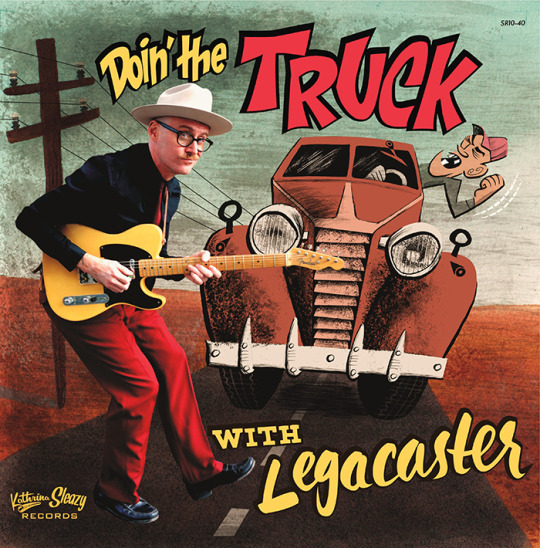
Legacaster publicará el próximo viernes 17 de junio “Doin’ The Truck With…”, nuevo lanzamiento editado en formato cedé y vinilo.
Después de lanzar Boppin' Guitar en 2015 y Big Berry durante 2017. El potente trío de Rock and Roll, Rockabilly, Country y Surf, regresa con "Doin' The Track With...". Nuevo álbum que contiene once canciones originales que versan sobre camiones, guitarras, relaciones y todo lo que se puede esperar en un disco de Rock and Roll.
Junto al Lega se suman al proyecto Berto Martínez (The Kabooms) en la batería y Juanma Rodríguez (Alice & The Wonders) al contrabajo, cuenta con colaboraciones de tanto peso como de Jake Calypso, Spencer Evoy (MFC Chicken) y Lynette Morgan (Tennessee Rhythm Ryders, The Blackwater Boys). El diseño del álbum está realizado por Marcel Bontempi, y lo publica Kathrina Records junto a Sleazy Records.
youtube
Acerca de Legacaster: Lega llegó a Barcelona en 2011 y pronto formó su banda Legacaster en bares y discotecas de la ciudad. después de varias formaciones con diferentes acompañantes, el combo definitivamente se convirtió en un trío.
En 2013 lanza un EP en vinilo con El Toro Records y comienzan las actuaciones dentro de la escena rockabilly local. En 2015, después de un año lleno de conciertos, la banda es reclutada en Kathrina Records y graban el primer álbum “Boppin' Guitar” que se edita tanto en vinilo como en CD. Este disco lleva a la banda a los escenarios de los festivales de dentro de la escena Rockabilly europea (España, Francia, Reino Unido, Alemania, Holanda, Italia, Bélgica, Suiza, etc. por citar algunos países donde presentaron sus credenciales con este trabajo. En 2017 vuelven graban esta vez un EP de 6 temas: "Big Berry" con el que llevan a cabo sus primeras giras por territorio nacional y Europa. Tres videoclips son lanzados a la vez durante este periodo y disponibles en Youtube.
Por otra parte Lega participa en varias formaciones destacadas con una amplia discografía disponible … Los Torontos, The Kabooms, Matt & The Peabody Ducks y ha compartido escenario tocando la guitarra para artistas como Barrence Whitfield, Rosie Flores, Marti Brom, Johnny Farina de Santo & Johnny (consagrados al éxito por su tema "Sleepwalker") South American el rockero clásico Johnny Tedesco, Carlos Bandido, etc.
Influencias musicales:
Guitarristas de Rock and Roll de los años 50 y principios de los 60 como Chuck Berry, Carl Perkins, entre otros.
Planes:
A fines de 2021, la banda grabó su nuevo álbum "Doin 'The Truck", que acaba de ser lanzado por Kathrina Records / Sleazy Records.
Se ha presentado en 2022 en Rockin Race Jamboree Festival en España, el pasado abril en el Viva Las Vegas USA, en junio en el Rockabilly Rave en UK, y en Septiembre en el High Rockabilly de Calafell. Con muchas ganas de presentar su nuevo disco en todos los lugares que quieran seguir divirtiéndose con la música Rock and Roll.
Fechas de Presentación: 11 de Junio, presentación y firma de disco en Disco 100, actuación en formato acústico, Calle Escorial 33. Gracia, Barcelona 16 al 20 de junio, Festival The Rockabilly Rave UK. Pontin's Cambers 22 al 24 de julio, Festival The Big Rumble en Pravia (Asturias) 13 de agosto, Festival Rave On The Beach! en El Prat (Barcelona) 11 de septiembre, Festival High Rockabilly en Calafell (Tarragona)
0 notes
Photo

Revisa nuestra nueva publicación en http://www.majos.cl/look/converse-conmemora-el-empoderamiento-y-resiliencia-con-su-coleccion-stronger-together/
Converse conmemora el empoderamiento y resiliencia con su colección Stronger Together
Con el objetivo de construir conexiones comunitarias más profundas para destacar el progreso e inspirar a mujeres y niñas de todo el mundo, Converse lanza una colección de edición limitada titulada Stronger Together (Juntas más fuertes), con la que busca encontrar el equilibrio de lo que esto significa: la lucha continua por la equidad.
La colorida colección está inspirada en las flores silvestres, conocida como la flor más resistente que crece de forma independiente y próspera colectivamente; simbolizando y celebrando la libertad, la felicidad y la unidad. El calzado incluye las siluetas Run Star Motion Ox, Chuck 70 y Chuck Taylor All Star.
Todos los diseños de las zapatillas, cuentan con una impresión en la parte interior de la lengüeta que dice “We Are Stronger Together” (Juntas somos más fuertes), como un pequeño recordatorio sobre la solidaridad que las mujeres comparten en la lucha por la igualdad. Además, tienen toques translúcidos y de color, partes superiores divididas que equilibran la rica paleta de colores y las opciones de materiales con los que están elaboradas.
Cada elemento fue elegido por el equipo de diseño liderado por mujeres con el objetivo de hacerlas sentir imparables, para que cuando el mundo exija lo mejor de ellas, demuestren su valentía y empoderamiento.
Converse Stronger Together ya está disponible en www.converse.cl y llegará a todas las tiendas del país paulatinamente a partir del viernes 11 de marzo. Sin embargo, los modelos las Chuck 70, llegarán al país la semana del 14 de marzo.
Para más información revisa nuestra cuenta de Instagram www.instagram.com/conversechile
0 notes
Photo
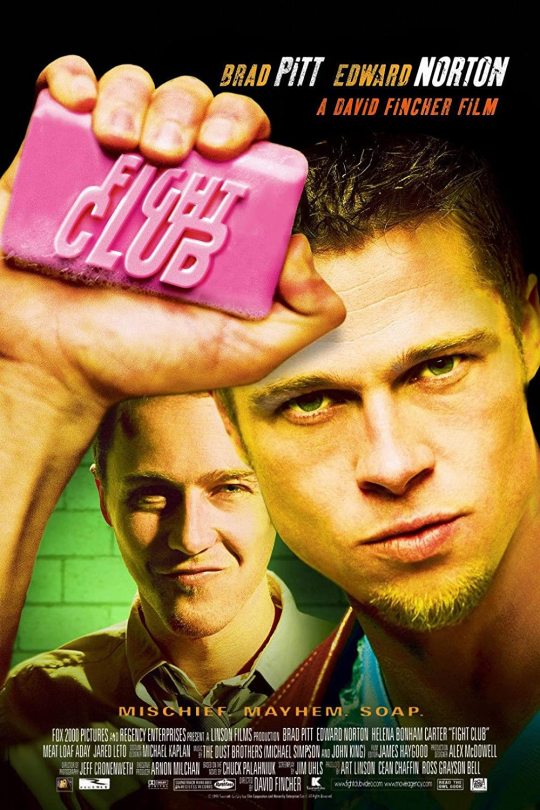

CALIFICACIÓN PERSONAL: 7 / 10
Título Original: Fight Club
Año: 1999
Duración: 139 min
País: Estados Unidos
Director: David Fincher
Guion: Jim Uhls. Novela: Chuck Palahniuk
Música: The Dust Brothers, Michael Simpson, John King
Fotografía: Jeff Cronenweth
Reparto: Edward Norton, Brad Pitt, Helena Bonham Carter, Meat Loaf, Jared Leto, Van Quattro, Markus Redmond, Michael Girardin, Rachel Singer, Eion Bailey, David Lee Smith, Zach Grenier, Richmond Arquette, David Andrews, George Maguire, Eugenie Bondurant, Christina Cabot, Sydney 'Big Dawg' Colston, Tim De Zarn, Christie Cronenweth, Ezra Buzzington, Dierdre Downing-Jackson, Bob Stephenson, Charlie Dell, Rob Lanza, Holt McCallany, Joel Bissonnette
Productora: Fox 2000 Pictures, Regency Enterprises, Linson Films, Atman Entertainment, Knickerbocker Films, Taurus Film
Género: Drama, Thriller
https://www.imdb.com/title/tt0137523/
TRAILER:
youtube
0 notes
Photo
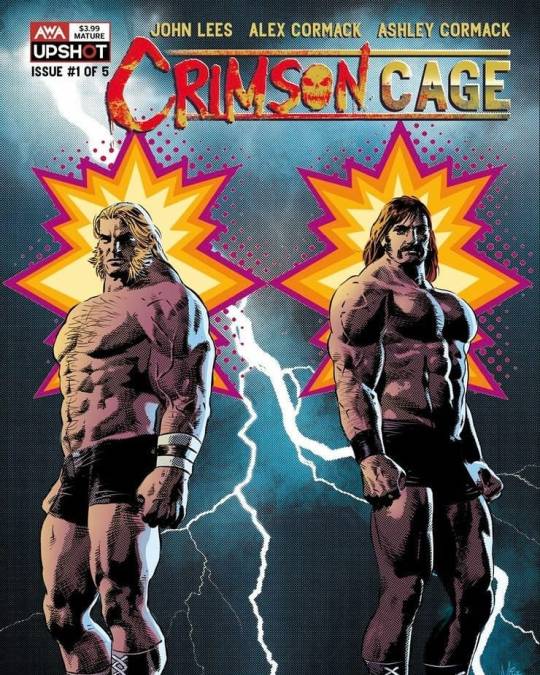
Adelanto de CRIMSON CAGE el nuevo comic de AWA que mezcla Shakespeare y Lucha libre de John Lees (Hotell) y Alex Cormack (Sea of Sorrows) El mundo de la lucha libre profesional está a punto de chocar con Shakespeare en Crimson Cage, un nuevo cómic que mezcla la acción de alto vuelo del negocio con la locura y el misticismo de MacBeth. Y lo crea o no, el resultado es demasiado bueno para que los fanáticos de cualquiera de los dos lo puedan dejar pasar. La nueva serie de AWA Studios puede sonar demasiado inesperada o demasiado perfecta para creerse: una reinvención de Macbeth, la trágica historia de Shakespeare de feroz fortuna y ambición, con el telón de fondo de la escena de lucha territorial de la Luisiana de los 80, y contada por voces, cuya familiaridad con la historia de la lucha libre profesional es evidente desde el primer panel. Inspirada en personas como Ricky Steamboat, Brutus Beefcake, Ric Flair y más, esta nueva historia del ambicioso 'Chuck Frenzy' cuenta con una reunión del equipo Sink de John Lees (Hotell) y Alex Cormack (Sea of Sorrows). El cabeza de cartel de una promoción de lucha libre local se lanza a la grandeza, cuando un encuentro casual con tres brujas misteriosas en el pantano de Luisiana lo lleva a la mayor oportunidad de su vida. Pero para reclamarlo, tendrá que cambiar el curso del destino ... haciendo lo impensable. Fuente @awastudiosofficial #creatorowned #comics #indiecomics #art #makecomics #indiecomicsart #comix #characterdesign #illustration #originalcomic #comicart #comicbooks #webcomic #character #drawing #comicpage #indie #comic #indiecreator #makingcomics #comicmaker #createcomics #design #drawings #igdaily #wrestling #wwe #prowrestling #smackdown #NXT https://www.instagram.com/p/CTjnxe7rVTj/?utm_medium=tumblr
#creatorowned#comics#indiecomics#art#makecomics#indiecomicsart#comix#characterdesign#illustration#originalcomic#comicart#comicbooks#webcomic#character#drawing#comicpage#indie#comic#indiecreator#makingcomics#comicmaker#createcomics#design#drawings#igdaily#wrestling#wwe#prowrestling#smackdown#nxt
0 notes
Text
Substance810 lanza "The Monolithic Era" (reseña del álbum)
Substance810 lanza “The Monolithic Era” (reseña del álbum)
Substance810 es un MC/productor de Port Huron, Michigan, que debutó en 2006. La definición bajo su apodo original Tekneek. Desde entonces, ha seguido construyendo un catálogo impresionante, ya sea la secuela La definición de… o el producto Hobgoblin Los Jardines Colgantes y más recientemente Chuck Chan produjo yermo esta última primavera. Pero a medida que se acercaba el otoño, Substance decidió…

View On WordPress
0 notes
Photo

09 de junio de 1997. Se lanza el álbum llamado "Demonic". Es el séptimo disco de estudio de la banda de thrash metal estadounidense Testament. Las letras se centran mayoritariamente más en temas ocultistas que en los aspectos políticos que insertaron en la década de 1980. Musicalmente Testament se vuelve más lento, orientándose al death metal, con riffs de guitarra afinadas en tonos bajos, y el trabajo vocal de Chuck Billy que consiste principalmente en voces guturales. https://youtu.be/ZwofnL2e0vE https://www.instagram.com/p/CBOYEUZpNQa/?igshid=t64bgi8beuwc
0 notes
Text
Asfixia de Chuck Palahniuk
¿Hace cuánto que no tienes sexo? ¿1 día?, ¿1 mes? ¡Da igual! Parece una típica pregunta de colegas en la que no siempre respondemos de manera honesta (¿qué chingados te importa?), pero para Víctor Mancini era tan importante como tomar un medicamento a su hora exacta, o añadir esa cantidad precisa de alguna sustancia química.
Asfixia (2001) es una novela escrita por el aclamado periodista estadounidense Chuck Palahniuk (quien ganó popularidad después de que su novela The Fight Club -1996- fuera publicada y más tarde adaptada al cine), quien se caracteriza por usar un lenguaje crudo, lleno de humor negro, a veces un poco incómodo. He estado leyendo que Chuck caracteriza muy bien la generación X, por estar simplemente decepcionada de todo; me pareció interesante porque creo que es un rasgo que no se determina porque hayas nacido en cierta época, sino tiene que ver con muchos factores que se comparten con otras generaciones y otros lugares. Tal vez por eso, personas como él y sus “fracasados” protagonistas nos crean empatía.
Este libro relata la vida de un adicto al sexo en recuperación, con una madre enferma interna en una residencia para ancianos, un trabajo que apenas le da para no ser un miserable y un cerebro capaz de manipular a la gente para hacerles creer que necesita de ellos, pero sobre todo de alguien que cree ciegamente en lo que le dice la gente en quien confía.
Yo lo describiría como una película donde hay varias escenas que no parecen tener la misma línea temporal y espacial pero que si sigues viendo vas a armar sin problema la historia. Creo que este libro en especial trata a la decepción como un ente que te recuerda que siempre hay manera de ir a peor. Claro, siempre que tú lo permitas. Victor se deja determinar por todos, es como si él no supiera qué hacer con su capacidad de elección y fuera como zombi perseguido por el pasado de su infancia y los secretos que su madre oculta de él en su diario que, curiosamente, alguien más debe descifrárselo, la doctora Paige. En su afán por descubrir verdades para entenderse a sí mismo y definir su camino, tiene toda clase de experiencias intensas (recordemos que es adicto al sexo) y, una persona solitaria con un único amigo. Todo lo que ha decidido creer se pone en juego cuando se enfrenta a sí mismo, y a una multitud encabronada.
Me gusta que en ningún momento pude anticiparme a lo que iba a ocurrir. Sinceramente me sorprendió. Algunos párrafos me causaron un poco de asco, por las escenas repugnantes que llega a describir. Creo que Chuck es un maestro del lenguaje sencillo y filoso. Me recordó bastante al protagonista de su texto “Guts”, y a mi perro cuando tiene problemas al expulsar sus desechos como Victor obstaculizado por un par de bolas de goma y no sabía si reírme o mirar a la gente para ver lo roja que tenían la nariz por el frío y olvidarme de culos y cacas.
Otro concepto que me gustó es el de “pasar límites” o “cruzar la línea”, una especie de “¿qué tanto es tantito?” (como la nueva adicción a ver series), ¿en qué momento te das cuenta que te pasaste de lanza? A veces es difícil identificar esas líneas invisibles, que nos llevan a experimentar situaciones que ponen en duda nuestra ética, principios, creencias, moral, ideas. No sabes supongo, hasta que sabes que no era una opción, o simplemente no te lo cuestionas y dejas que el hilo siga hasta que se tope con algo más que lo haga parar. Apatía no es la mejor palabra, pero es la primera que se me viene a la mente (ja).
Es un libro que recomiendo si eres sarcástico y con humor negro. Si quieres reírte un rato. Si tienes problemas para saber definir tus límites, o simplemente si quieres leer algo y no sabes qué o si no tienes nada mejor que hacer, lee Asfixia.
1 note
·
View note
Photo

Revisa nuestra nueva publicación en http://www.majos.cl/look/peace-unity-converse-lanza-coleccion-inspirada-en-la-comunidad-del-baloncesto/
Peace & Unity: Converse lanza colección inspirada en la comunidad del baloncesto
Esta nueva colección está inspirada en la comunidad del baloncesto que está formada por gente que sabe perseverar, mostrar su estilo, animarse los unos a los otros y mostrar su apoyo. Así mismo, Peace & Unity fomenta el espíritu de ellos y ellas mientras siguen encontrando cosas por las que alegrarse dentro y fuera de la cancha.
Los clásicos de Converse como las Chuck 70, y nuevas versiones como las Weapon CX y BB Jet llegan con estampados atrevidos que presentan una combinación de gráficos modernos y populares que emanan calidez, esperanza y positividad. Además, tienen un corte alto premium con parte superior de lona orgánica, parche en el tobillo vintage con forma de estrella y logotipo de goma en el talón para conectar con el legado de los años ‘70. Asimismo, presenta una parte lateral de goma brillante y cordones de algodón premium para un estilo más sofisticado y plantilla OrthoLite que mantiene la comodidad.
La colección Peace & Unity de Converse incluye 3 siluetas de zapatillas, además de ropa y accesorios. Actualmente se encuentran en stock los modelos de BB Jet y Chuck 70, sin embargo, las Weapon, llegarán la próxima semana. Las puedes encontrar directamente en la página web www.converse.cl o en las tiendas Converse de Antofagasta, Costanera Center, Plaza Vespucio, Florida Center, Plaza Oeste y Marina Arauco.
1 note
·
View note